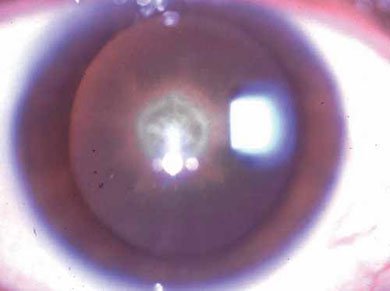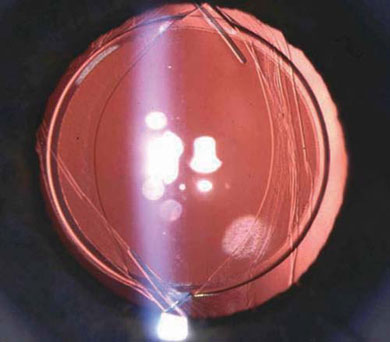What Should I Do Differently With a Posterior Polar Cataract?
Posterior polar cataract represents one of the uniquely challenging situations for the anterior segment surgeon. The condition, a dominantly inherited disorder with variable expressivity, may be associated with intraoperative defects in the posterior capsule. Because the condition is dominantly inherited, typically both eyes are involved and there is no gender preference. However, posterior lenticonus, a similar physical phenomenon, is more typically uniocular, has a tendency for females, and is generally diagnosed in the first decade of life. Previous publications indicate as high as a 26% likelihood for a defective capsule at the time of cataract surgery.1 It is unclear whether the defect in the capsule is pre-existent or develops iatrogenically because of marked thinning.
Can one tell if the capsule is defective prior to surgery? Daljit Singh, an extraordinarily prolific Indian surgeon, has described a sign that he suggests is indicative of a defect in the capsule. His sign is that of a series of satellite minicataracts surrounding the main posterior polar plaque. In his view, the congenitally defective capsule allows aqueous to permeate into the lens material and induce small secondary opacities. In my surgical experience, a defective capsule in one eye is most often met with a defective capsule in the second eye. Likewise, the earlier in life the patient presents with symptoms, the greater the likelihood for a defective capsule. Conversely, elderly patients with posterior polar cataract in addition to nuclear or other age-related cataract formation, in my experience, tend not to have defective capsules.
Most patients with posterior polar cataracts present with symptoms as they start to become presbyopic because the loss of accommodation teams with the evolving cataract near the nodal point to significantly reduce reading ability. Physical findings most typically are that of a fully normal examination with the exception of the posterior polar plaque-like cataract, which is three-dimensional; it may have the appearance of a hockey puck (Figure 23-1). I have not been impressed with any other typical abnormalities in eyes with posterior polar cataracts.

Figure 23-1. Classic appearance of central posterior polar cataract.
In any case, because of the proclivity for a defective posterior capsule in a significant proportion of cases, a surgical strategy must be adapted in order to preclude serious intraoperative complications should capsule rupture occur. Moreover, the strategy will prepare the surgeon for dealing with capsule rupture under other circumstances. When counseling such a patient in preparation for surgery, I spend considerable time discussing the increased risk and nature of complications. I may spend as much chair time discussing the situation as I do operative time fixing the problem.
Experienced surgeons should be comfortable with topical/intracameral anesthesia; however, given the likelihood for prolonged surgery, one might plan for alternative anesthetic strategies and be prepared to convert to sub-Tenon’s infiltration intraoperatively.
Incisional and astigmatism considerations are routine; however, one should be certain to create a self-sealing incision in order to avoid shallowing of the anterior chamber as instruments are removed. The anterior capsulorrhexis is of particular importance. If the posterior capsule is defective, it is very beneficial to use the remaining anterior capsule to capture the optic of the implant (Figure 23-2). Therefore, the capsulorrhexis must be intact, well centered, and somewhat smaller than the size of the planned optic. With respect to machine fluidic parameters, given a risk for a defect in the posterior capsule it is wise to reduce inflow during surgery. As a result, aspiration flow rate and vacuum must also be lowered, in keeping with the “slow motion” technique described by Osher.1

Figure 23-2. Optic capture. The IOL loops are situated anterior to the capsule bag while the optic has been deliberately displaced behind the anterior capsulorrhexis, creating stable fixation.
The surgical hallmark in management of posterior polar cataract is avoiding hydrodissection because hydrostatic pressure may “blow out” the defective or weakened posterior capsule. Instead, hydrodelineation is employed to separate the endonucleus from the epinucleus and cortex. As a rule, the endonucleus is soft and can be removed by simple emulsification without the need for rotation, which risks stressing the posterior capsule. Should the nucleus be firmer, vertical chopping and elevation of the nuclear halves away from the epinucleus is a generally successful strategy. Following removal of the endonucleus, I use a dispersive ophthalmic viscosurgical device (OVD) to dissect the cortex and epinucleus away from the posterior capsule. Generally, I employ small aliquots in multiple locations but do not allow the agent to reach the posterior pole of the lens. Next, I use bimanual irrigation and aspiration (I/A) (this affords a safety factor if the capsule opens) to remove the cortex and epinucleus from the peripheral aspect of the capsule bag, leaving behind the posterior polar plaque until all other lens material has been aspirated. In this manner, should the capsule rent, little to no material can fall into the posterior segment. If the capsule remains intact, surgery is routine from this point forward. However, the capsule will often have small fragments of residual lens opacity. I prefer to leave these and open the capsule with the Nd:YAG laser postoperatively as necessary.
On the other hand, if a rent in the capsule occurs, the surgeon should not withdraw the handpieces rapidly from the eye. Instead, the infusion bottle should be lowered, only the aspiration device removed, and air or OVD added to maintain a formed anterior chamber as the infusing handpiece is removed. Hopefully, that strategy will prevent anterior movement of the vitreous and extension of the capsular defect; in turn, this may allow the surgeon to convert the defect into a posterior circular capsulorrhexis. Nonetheless, in my experience, once the capsule ruptures, the defect extends rapidly because the capsule is thinner than normal. In the presence of a capsule defect, I remove all remaining cortex with a low flow or “dry” bimanual fashion; residual cortex, especially when mixed with vitreous, can induce long-term inflammation and cystoid macular edema. It is also essential to remove vitreous from the anterior chamber bimanually; this may be facilitated by a pars plana approach and with the use of triamcinolone staining of the vitreous. Once the anterior segment is free of cortex and vitreous, an intraocular lens may be implanted as dictated by the condition of the anterior/posterior capsules. As mentioned above, it is my preference to place the IOL in the ciliary sulcus and then capture the optic behind the anterior capsule. The viscoagent is removed bimanually either with I/A or with the automated vitrector. As with all cataract surgery, I leave the eye at physiologic intraocular pressure and test all incisions with fluorescein dye to assure hermetic sealing.
References
1. Osher RH, Yu BC, Koch DD. Posterior polar cataracts: a predisposition to intraoperative posterior capsular rupture. J Cataract Refract Surg. 1990;16(2):157-162.
